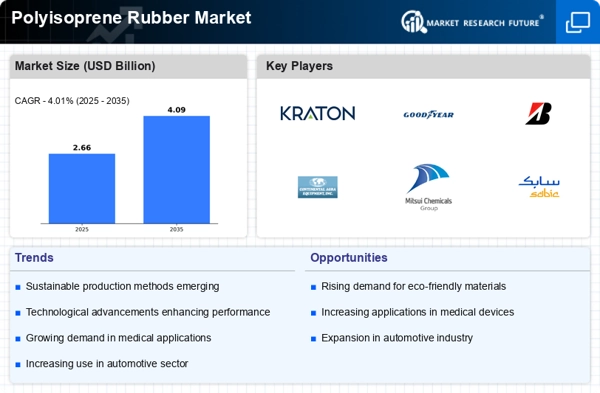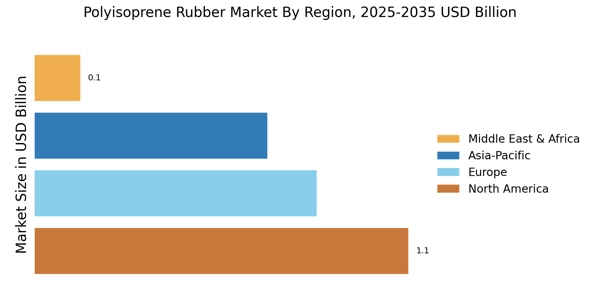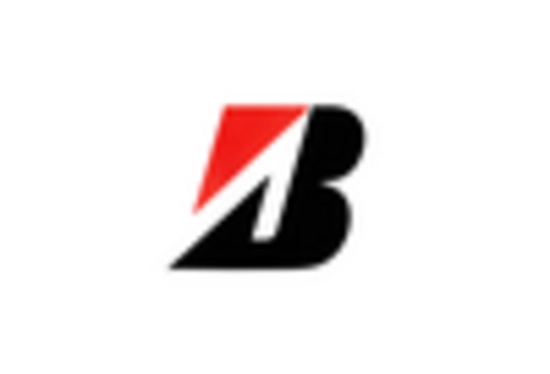Rising Consumer Awareness
Rising consumer awareness regarding product quality and safety is influencing the Polyisoprene Rubber Market. Consumers are becoming more discerning about the materials used in everyday products, particularly in sectors such as food packaging and personal care. Polyisoprene's non-toxic and safe characteristics make it an attractive option for manufacturers aiming to meet these consumer expectations. Market Research Future indicates that products made with polyisoprene are increasingly favored, potentially leading to a 15% increase in market share within the next few years. This heightened awareness is likely to drive the Polyisoprene Rubber Market forward, as companies adapt their offerings to align with consumer preferences for safe and high-quality materials.
Automotive Industry Growth
The growth of the automotive industry serves as a vital driver for the Polyisoprene Rubber Market. As automotive manufacturers seek to enhance vehicle performance and fuel efficiency, the demand for lightweight and durable materials has increased. Polyisoprene is increasingly being used in tire manufacturing, seals, and gaskets due to its excellent mechanical properties. Recent data indicates that the automotive sector is projected to grow at a rate of 4% annually, which could lead to a corresponding increase in polyisoprene consumption. This trend suggests that the Polyisoprene Rubber Market will likely experience a surge in demand as automotive applications expand, further solidifying its market position.
Sustainability Initiatives
The increasing emphasis on sustainability initiatives is a pivotal driver for the Polyisoprene Rubber Market. As industries strive to reduce their carbon footprint, the demand for eco-friendly materials has surged. Polyisoprene, being a synthetic rubber derived from renewable resources, aligns well with these sustainability goals. Companies are increasingly adopting polyisoprene in various applications, including automotive and consumer goods, due to its biodegradable properties. This shift towards sustainable materials is projected to enhance the market's growth, with estimates suggesting a compound annual growth rate of around 5% over the next few years. The Polyisoprene Rubber Market is thus likely to benefit from this trend as manufacturers seek to meet consumer preferences for environmentally responsible products.
Technological Advancements
Technological advancements play a crucial role in shaping the Polyisoprene Rubber Market. Innovations in polymerization techniques and processing methods have led to the development of high-performance polyisoprene products. These advancements enable manufacturers to produce polyisoprene with enhanced properties, such as improved elasticity, durability, and resistance to heat and chemicals. As a result, the applications of polyisoprene are expanding into sectors like aerospace and electronics, where performance is paramount. Market data indicates that the introduction of advanced polyisoprene formulations could potentially increase market penetration by 10% in the next five years. Consequently, the Polyisoprene Rubber Market is poised for growth as companies leverage these technological improvements to meet evolving consumer demands.
Growing Demand in Healthcare
The growing demand in the healthcare sector is a significant driver for the Polyisoprene Rubber Market. Polyisoprene is widely utilized in medical applications, including surgical gloves, catheters, and other medical devices, due to its biocompatibility and hypoallergenic properties. The healthcare industry's expansion, driven by an increasing focus on hygiene and safety, is expected to propel the demand for polyisoprene products. Market analysis suggests that the healthcare segment could account for over 30% of the total polyisoprene consumption by 2026. This trend indicates a robust growth trajectory for the Polyisoprene Rubber Market, as manufacturers respond to the rising need for high-quality medical supplies.


















Leave a Comment